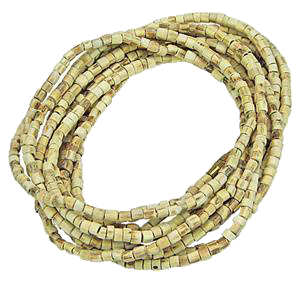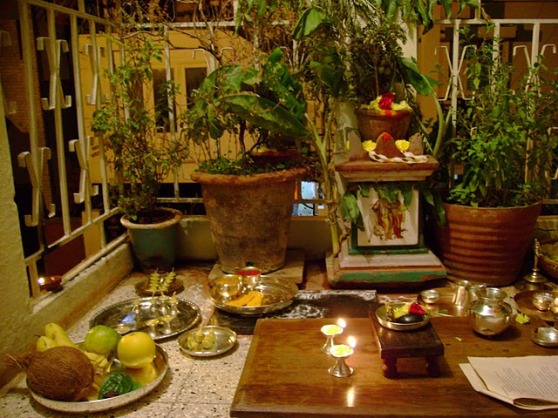 Tulsi is thought to be the most sacred of woods in India and Indian worship, and the plant of Tulsi is believed to be the incarnation of the Divine itself. The Tulsi Mala is made of the wood or the seeds of Tulsi and is used for name chanting and worship.
Tulsi is thought to be the most sacred of woods in India and Indian worship, and the plant of Tulsi is believed to be the incarnation of the Divine itself. The Tulsi Mala is made of the wood or the seeds of Tulsi and is used for name chanting and worship.
Moreover, the Tulsi Mala is said to have incredible spiritual and physical healing powers apart from helping the mind to focus during prayers. Like the Sphatik Mala and the Rudraksh Mala.
The Tulsi Mala is made of Tulsi wood and consists of 108 beads wound around a strong string, with a 109th bead called the Sumeru bead of some other material like a metal or crystal, or a bigger Tulsi bead itself. One starts counting the beads from the bead adjacent to the Sumeru bead of the Tulsi Mala and completes one full round. On second round the Tulsi Mala needs to be counted in the reverse direction again as the Sumeru bead should not be crossed while praying. Depending on the type of the Tulsi plant, the Tulsi Mala is available in various colors like black, brown or sandalwood color.
The Tulsi Mala can be worn on the neck or tied around the fist. The benefits of the leaves of Tulsi is well proven, and owing to its spiritual and physical healing powers, the touch of the Tulsi wood acts as a rejuvenator for the stressed mind and brings the spiritual self of a person closer to God. On top of that, wearing the Tulsi Mala is supposed to bring good luck and fortune to the devoted wearer. It is said to balance the kapha and the vata dosha. Tulsi clears the aura, and its subtle smell fills the heart with sensation of the divine. The Tulsi Mala is used to worship Lord Ram and Krishna, different incarnations of Lord Vishnu who is believed to be the creator and the beloved of the Tulsi.
The Lord says that one who wears the beads made out of the wood of Tulsi in one’s neck, even if he is untidy and ill- charactered, will undoubtedly attain Me only. Sri Krishna will grant the fruit of being the resident of Dvarka immediately to those who wear Tulsi beads around the neck. The sins of the person who wears neck beads made of Tulsi with devotion after offering to Sri Vishnu will get vanquished and Devakinandan Sri Krishna will always remain pleased with him, he does not need to undergo further atonement, no more sins remain in his body. In Kaliyuga, one, who is bedecked with the beads made of Tulsi, performs ritual activities and activities pertaining to ancestors and demigods, obtains crores times more results. The messengers of Yama will flee away by the sight of the Tulsi beads just as leaves are blown off by wind.
In Skanda-puran it is stated :- Those who wear neck beads made of Tulsi after offering it to Sri Hari are definitely foremost among the devotees of Lord. After presenting the mala, it should be purified with panca-gavya; after that the mula -mantra should be recited followed by the recitation of the gayatri mantra for eight times. Touching with incense, worship with this
Sadyojata -mantra with utmost devotion:
Om sadyojatah prapadyami sadyojataya vai namo namah.
Bhave tave nadi bhave bhajeswamam bhavod-bhavaya namah After that, this prayer should be made, “Oh! Mala ! You are made of Tulsi and are dear to Vaisnavas . I wear you around my neck; you make me dear to Sri Krishna. ‘Ma’ means ‘me’, ‘La’ means ‘to give’. Oh Hari-Vallabhe ! You have given me to Vaisnava devotees, hence you are known as mala . Those Vaisnavas who pray in accordance with rituals in this manner and first offer the mala in the neck of Sri Krishna and then puts it to themselves attain the Lotus feet of Sri Vishnu.” It is stated in Padma Purana : either during morning ablutions or bathing or eating or at any state which is clean or unclean, Tulsi mala has to be worn always; that means mala should not be removed under any circumstance.
Health Benefits of Tulsi (Sciance)
– It acts as anti bacterial and anti parasitic, therefore is widely used in infectious diseases.- Tulasi act on nervous system providing them strength, relieves stress and helps in relieving
pain.
– It work as appetizer and promotes digestion by helping in secretion of digestive enzymes.
– Tulsi juice when mixed with ginger juice is very effective in abdominal disorder in children.
– It helps in preventing flatulence and avoids constipated stool.
– It is an effective natural cure for upper respiratory tract infection (URTI).
– Tulasi works as good expectorant relieving from wet cough.
– It is very useful in bronchitis and asthmatic conditions.
– It works as antibiotic eliminating the bacteria.
– It is widely used in fever as it act as antipyretic, pain reliever, and provides strength to our body.
Take powder of Tulasi leaves with saunth (dried ginger) and sugar with hot water in fevers.
– It also possesses anti-cancerous properties.
– Tulsi juice drops are very effective in earache.
– Keep powder of tulsi root in water for overnight and take it early morning for diabetes natural cure.
– It works as a powerful antioxidant thereby helps in preventing early aging signs and makes the skin
young.
“Jai Shri Radhe”
 Bhakti yoga practice includes chanting the Hare Krishna mantra softly to oneself. This is called japa.
Bhakti yoga practice includes chanting the Hare Krishna mantra softly to oneself. This is called japa.


You must be logged in to post a comment.